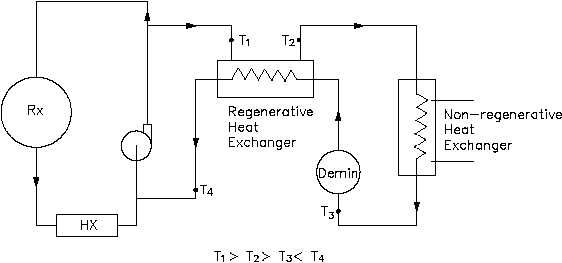Heat Transfer
HEAT EXCHANGERS
Rev. 0
Page 35
HT-02
Figure 12 Regenerative Heat Exchanger
The second is to reduce the temperature of the water entering the purification system prior to
reaching the non-regenerative heat exchanger, allowing use of a smaller heat exchanger to
achieve the desired temperature for purification. The primary advantage of a regenerative heat
exchanger application is conservation of system energy (that is, less loss of system energy due
to the cooling of the fluid).
Cooling Towers
The typical function of a cooling tower is to cool the water of a steam power plant by air that
is brought into direct contact with the water. The water is mixed with vapor that diffuses from
the condensate into the air. The formation of the vapor requires a considerable removal of
internal energy from the water; the internal energy becomes "latent heat" of the vapor. Heat and
mass exchange are coupled in this process, which is a steady-state process like the heat exchange
in the ordinary heat exchanger.
Wooden cooling towers are sometimes employed in nuclear facilities and in factories of various
industries. They generally consists of large chambers loosely filled with trays or similar wooden
elements of construction. The water to be cooled is pumped to the top of the tower where it is
distributed by spray or wooden troughs. It then falls through the tower, splashing down from
deck to deck. A part of it evaporates into the air that passes through the tower. The enthalpy
needed for the evaporation is taken from the water and transferred to the air, which is heated
while the water cools. The air flow is either horizontal due to wind currents (cross flow) or
vertically upward in counter-flow to the falling water. The counter-flow is caused by the

